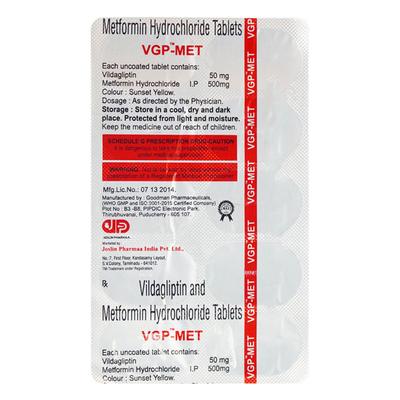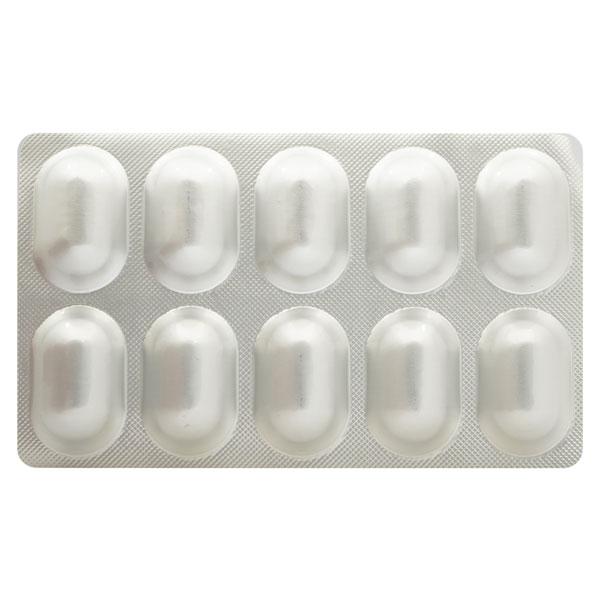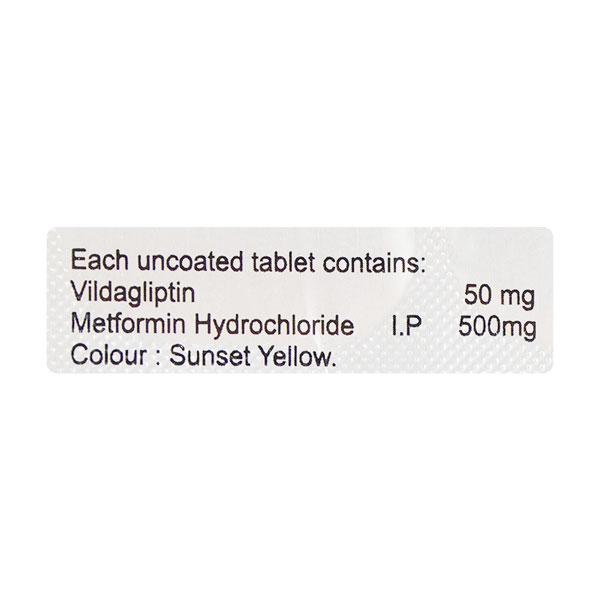

Netmeds First Membership
Quick Links
Introduction About VGP MET TABLET
VGP MET TABLET is used to manage type 2 diabetes (non-insulin-dependent diabetes mellitus) in adult patients whose diabetes cannot be controlled by diet and exercise alone and/or with other medicines used to manage diabetes (insulin or sulphonylureas such as glimepiride and glipizide). It is a combination of Metformin and Vildagliptin which belongs to a group of medicines called Antidiabetic agents.
Before taking VGP MET TABLET, inform your doctor if you have liver, kidney, or heart problems. It should be used during pregnancy only if advised by your doctor, and it is not recommended for pregnant women. VGP MET TABLET is not suitable for use in children and adolescents under 18 years of age, and it should be used with caution in elderly patients (65 years of age and above).
Avoid consumption of alcohol during management with VGP MET TABLET, as it may increase the risk of lactic acidosis. The most common side effects of taking VGP MET TABLET are stomach pain, low blood sugar, and diarrhea. Contact your doctor if any of the symptoms worsen.
Uses Of VGP MET TABLET
- Used to manage type II diabetes mellitus (whose diabetes cannot be controlled by diet and exercise alone and/or with other medicines used to manage diabetes)
How VGP MET TABLET Works
VGP MET TABLET helps to control the blood sugar level, where Metformin makes the body more sensitive to insulin (a hormone involved in glucose metabolism). This helps our body cells utilize more of the circulating blood glucose. Additionally, it can stop glucose production by the liver and reduce its absorption in the body. Vildagliptin controls blood sugar levels by blocking the actions of an enzyme called dipeptidyl peptidase (DPP)-4 that indirectly increases insulin secretion in the body. Collectively, VGP MET TABLET controls blood sugar levels in patients with type II diabetes.
How to use VGP MET TABLET
- Take VGP MET TABLET as directed by your physician
- Swallow the medicine as a whole and do not crush or chew the medicine
- Your doctor will decide the correct dose and duration for you, depending on your age and health condition
- Do not stop taking VGP MET TABLET without informing your doctor
Side Effects Of VGP MET TABLET
Common Side Effects of VGP MET TABLET:
- diarrhea
- stomach pain
- loss of appetite
- metallic taste
- low blood glucose
- joint pain, tiredness
- constipation
- swollen hands, ankles, or feet (oedema)
Stop taking VGP MET TABLET and contact your doctor immediately if you experience any of the following side effects:
- symptoms of lactic acidosis (such as vomiting, stomach pain, decreased heartbeat, difficulty breathing, muscle cramps, general weakness with severe tiredness, or reduced body temperature)
- signs of an inflamed pancreas (severe and persistent pain in the abdomen with or without nausea or vomiting)
Warning & Precautions
Pregnancy
Monitoring requiredVGP MET TABLET is not recommended for pregnant women unless it is considered necessary.
Breastfeeding
ContraindicatedVGP MET TABLET is not recommended for use by breastfeeding women.
Driving and Using Machines
Use with CautionDo not drive or operate any machines if you experience dizziness after taking VGP MET TABLET.
Alcohol
Consult your doctorConsumption of alcohol is not recommended during management with VGP MET TABLET since it may increase the risk of lactic acidosis.
Kidney
ContraindicatedVGP MET TABLET is not recommended in patients with severely reduced kidney function.
Liver
ContraindicatedVGP MET TABLET is not recommended in patients with liver disease.
Allergy
ContraindicatedDo not take VGP MET TABLET if you are allergic (hypersensitive) to Metformin, Vildagliptin or any other ingredients of this medicine.
Heart Disease
ContraindicatedVGP MET TABLET is not recommended in patients who recently had a heart attack or heart failure or any signs of heart problems such as serious blood circulation problems or difficulty breathing.
Use In Pediatrics
ContraindicatedVGP MET TABLET is not recommended for use in children and adolescents less than 18 years of age due to a lack of safety and effectiveness.
Use In Geriatrics
Use with CautionVGP MET TABLET should be used with caution in elderly patients above 65 years of age, especially in patients with impaired kidney function. Your doctor will adjust the dose depending on kidney function, and your kidney function will be monitored regularly.
Others
VGP MET TABLET is not recommended for you if you have:
- Type 1 diabetes mellitus
- Uncontrolled diabetes
- Severe infection or seriously dehydrated
- are going to have a contrast x-ray (a specific type of x-ray involving an injectable dye)
Before taking VGP MET TABLET, inform your doctor if you have or had:
- pancreatic disease
- Vitamin B12 deficiency
- Malnutrition with adrenal or pituitary insufficiency
Interactions
A. Drug-Drug interactions:
Before taking VGP MET TABLET, inform your doctor if you are taking any of these medicines:
- Glucocorticoids (Ex. dexamethasone and prednisolone)
- Beta-2 agonists (Ex. albuterol and terbutaline)
- Diuretics (Ex. chlorthalidone and hydrochlorothiazide)
- NSAID’s (Ex. Ibuprofen and celecoxib)
- Angiotensin-converting enzyme (ACE) inhibitors (Ex. enalapril, lisinopril)
- Angiotensin II receptor antagonists (Ex. losartan, telmisartan)
- Antidiabetics (Ex. glimepiride, glipizide)
- Anti-anginal (Ex. Ranolazine)
- Anti-viral agents (Ex. Dolutegravir)
- Kinase inhibitors (Ex. Vandetanib)
- H2 blockers (Ex. Cimetidine)
Overdosage:
If you or anyone else accidentally takes too much of VGP MET TABLET, consult your doctor immediately. Overdosage symptoms of VGP MET TABLET might include low blood sugar levels, lactic acidosis, muscle pain, mild and transient burning or tickling sensations in the body, fever, and oedema.
Synopsis
| Drug | : | Metformin, Vildagliptin |
| Pharmacological Category | : | Biguanides, Dipeptidyl peptidase 4 inhibitors |
| Therapeutic Indication | : | Type II diabetes mellitus |
| Dosage Forms | : | Tablet |
More Information
FAQs About VGP MET TABLET
Q: What is VGP MET TABLET used for?
A: VGP MET TABLET is a combination medication containing vildagliptin and metformin. It is used to manage type 2 diabetes mellitus in adults by improving blood sugar control. Vildagliptin is a DPP-4 inhibitor that increases insulin secretion and decreases glucagon production, helping to regulate blood sugar levels after meals. Metformin reduces glucose production in the liver and improves the body’s response to insulin. Together, they are effective for patients whose blood sugar levels are not controlled with metformin or vildagliptin alone.
Q: What are the side effects of VGP MET TABLET Tablet?
A: The most common side effects of taking VGP MET TABLET Tablet are nausea, vomiting, stomach pain, headache, low blood sugar, and diarrhea. Contact your doctor if any of the symptoms worsen.
Q: Which is better, VGP MET TABLET or metformin?
A: VGP MET TABLET (vildagliptin) and metformin are used for different purposes in diabetes management. Metformin is often the first-line treatment due to its proven efficacy, safety, and cost-effectiveness. VGP MET TABLET is added when metformin alone does not provide adequate blood sugar control. VGP MET TABLET is more effective when combined with metformin (as in VGP MET TABLET), as the dual therapy addresses blood sugar control from multiple pathways. The choice depends on individual needs, tolerability, and doctor recommendations.
Q: Is VGP MET TABLET to be taken before or after food?
A: VGP MET TABLET should be taken after food to minimize gastrointestinal side effects like nausea or stomach upset. Following your doctor’s instructions regarding timing and dosage is essential for optimal results.
Q: Does VGP MET TABLET cause weight loss?
A: VGP MET TABLET is generally weight-neutral, meaning it does not significantly cause weight gain or loss. However, metformin in the combination may contribute to mild weight loss in some individuals by improving insulin sensitivity and reducing appetite. Vildagliptin typically has no direct effect on weight.
Q: Does VGP MET TABLET cause constipation?
A: Constipation is not a common side effect of VGP MET TABLET. On the contrary, metformin (part of VGP MET TABLET) is more likely to cause diarrhea or loose stools. However, individual responses vary, and if constipation occurs, it is usually mild and manageable with dietary changes and increased hydration.
Q: Does VGP MET TABLET contain metformin?
A: The basic VGP MET TABLET tablet contains only vildagliptin. The VGP MET TABLET, however, is a combination of vildagliptin (50 mg) and metformin (500 mg or 1000 mg). Ensure you are prescribed the correct formulation based on your treatment plan.
Q: How to use VGP MET TABLET?
A: VGP MET TABLET should be taken as directed by your doctor. Typically:
Swallow the tablet whole with water, preferably after a meal to reduce stomach upset.
Do not skip doses or stop the medication suddenly without consulting your doctor.
Monitor your blood sugar levels regularly to ensure the medication is effective
Q: What are the benefits of VGP MET TABLET?
A: The benefits of VGP MET TABLET include:
Effective blood sugar control: By combining two complementary mechanisms (vildagliptin and metformin).
Weight neutrality: Suitable for overweight patients.
Low risk of hypoglycemia: Compared to sulfonylureas or insulin.
Convenience: Combining two medications in one tablet simplifies treatment.
Prevention of complications: Delays the onset of diabetes-related complications like neuropathy and cardiovascular issues.
Q: Does vildagliptin increase creatinine?
A: Vildagliptin does not directly increase creatinine levels, but it should be used with caution in patients with kidney impairment. Kidney function must be monitored during treatment, as vildagliptin is partially excreted by the kidneys. Metformin in VGP MET TABLET also requires caution due to the risk of lactic acidosis in kidney impairment.
Q: Which is better, vildagliptin or metformin?
A: Metformin is the preferred first-line management for type 2 diabetes due to its long-term safety, efficacy, and affordability. Vildagliptin is added for patients who need additional blood sugar control. The combination (as in VGP MET TABLET) often provides better results than either drug alone. The choice depends on individual needs and doctor recommendations.
Q: When should I stop taking vildagliptin?
A: Vildagliptin should be stopped if:
Significant side effects occur, such as severe liver enzyme elevation or allergic reactions.
It is ineffective in controlling blood sugar, and an alternative treatment is needed.
Your doctor recommends discontinuation due to contraindications like kidney or liver dysfunction.
Always consult your doctor before stopping the medication.
Q: Is VGP MET TABLET safe?
A: VGP MET TABLET is generally safe when used as prescribed. However, patients with kidney, liver, or heart conditions should use it cautiously under medical supervision. Regular monitoring of blood sugar levels, kidney function, and liver enzymes is essential to ensure safety.
Q: When is the best time to take VGP MET TABLET?
A: VGP MET TABLET is best taken after meals to reduce the risk of gastrointestinal side effects. Follow your doctor’s timing and dosing instructions for optimal results.
Q: When to take VGP MET TABLET 50/500?
A: VGP MET TABLET 50/500 is typically taken once or twice daily, as prescribed, after meals. Taking it with food helps improve tolerance to metformin and reduces side effects like nausea.
Q: Is Galvus and VGP MET TABLET the same?
A: Yes, Galvus and VGP MET TABLET are essentially the same as both contain vildagliptin. Galvus is the brand name by Novartis, while VGP MET TABLET is marketed by another pharmaceutical company. Both are used for managing type 2 diabetes, and their effectiveness is similar. The choice between them depends on availability, cost, and doctor recommendations.
References
1. KD Tripathi MD. Hormones and related drugs. Essentials of Medical Pharmacology. Seventh edition. New Delhi, May 2013. Page-274.
2. Paresh Ved and Samrat Shah. Evaluation of vildagliptin and fixed dose combination of vildagliptin and metformin on glycemic control and insulin dose over 3 months in patients with type 2 diabetes mellitus. March 2012. [Accessed on 30th June 2021] click here
3. Serge Halimi, Anja Schweizer, Biljana Minic, James Foley and Sylvie Dejage. Combination treatment in the management of type 2 diabetes: focus on vildagliptin and metformin as a single tablet. March 2008. [Accessed on 30th June 2021] click here
4. Novartis Pharma GmbH. Electronic Medicines Compendium (EMC) [Revised in August 2021] [Accessed on 30th June 2021] click here
5. Cipla Ltd. VYSOV-M Tablets (Vildagliptin + Metformin hydrochloride). [Revised in July 2020] [Accessed on June 30, 2021] click here










